2013 VOLKSWAGEN CC suspension
[x] Cancel search: suspensionPage 57 of 578

Length 189 in – 193 in (4802 –
4902 mm)
Width 73 in (1855 mm)
Height (unloaded) 55.7 – 56.1 in (1417 –
1425 mm)
Wheelbase 106.6 in (2708 mm)
Minimum turning circle diameter
(wall to wall)2
37.4 ft (11.4 m)
Track2, front 61.1 – 61.3 in (1552 –
1556 mm)
Track2, rear 61.3 – 61.5 in (1557 –
1562 mm)
Ground clearance (unloaded) 4.9 in (124 mm)
NOTICE
� Please be careful when parking your vehicle in areas with
parking barriers or curbs. These vary in height and could dam-
age your bumper and related parts if the front of your vehicle
hits a barrier or curb that is too high while you are getting into or
out of a parking spot.
� Always be careful when you enter a driveway or drive up or
down steep ramps or over curbs or other obstacles. Parts of the
vehicle close to the ground may be damaged (such as bumper
covers, spoilers, and parts of the engine, suspension, and ex-
haust systems).
2 Slight differences to these figures are possible, depending on wheel and tire size fitted and the level selected.
Page 235 of 578

sure values stored in your vehicle's TPMS may have to be adjusted
(reprogrammed). This requires professional assistance. For more
information, contact your authorized Volkswagen dealer or authorized
Volkswagen Service Facility.
Installing replacement tires with steel cord body plies in the tire side-
wall may cause malfunction of the TPMS, and is not recommended
(cord material information in molded on the tire sidewall).
Always check the TPMS indicator light after replacing one or more
tires on your vehicle. If the indicator light is on, the TPMS is not work-
ing properly. Your replacement tire might be incompatible with the
system, or some component of the TPMS may be damaged.
For detailed information about TPMS, how it works and what you
need to know ⇒ Tire Pressure Monitoring System (TPMS).
WARNING
New tires tend to be slippery and must be broken in.
� Always drive with special care for the first 350 miles (560 km)
to help reduce the risk of losing control, a collision, and serious
personal injuries.
WARNING
Tires must have the required clearance. Tires that do not have
enough clearance can rub against parts of the vehicle body,
suspension, and brake system, causing brake system failure,
tread delamination, and sudden blowouts.
� Always make sure that new tires are not larger than the tires
approved for your vehicle and that the new tires do not rub
against parts of the vehicle.
NOTICE
� When switching to different tires, make certain the valves and
sensors are not damaged.
� Never drive without valve stem caps. The valves and sensors
could be damaged.
Page 243 of 578

� Driving style.
� Unbalanced wheels.
� Wheel alignment.
Driving style – Fast cornering, hard acceleration and braking increase
tire wear. If you experience increased tire wear under normal driving
conditions, have the vehicle suspension checked by an authorized
Volkswagen dealer or an authorized Volkswagen Service Facility.
Unbalanced wheels – The wheels on a new vehicle are balanced.
When driving, however, various conditions can cause a wheel to be-
come unbalanced. Unbalanced wheels can cause wear to the steer-
ing and suspension systems. Have all wheels rebalanced. A wheel
must always be rebalanced if a new tire has been mounted.
Wheel alignment – Incorrect wheel alignment causes excessive and
uneven tire wear, impairing vehicle safety. If you notice excessive or
uneven tire wear, have the wheel alignment checked by an author-
ized Volkswagen dealer or an authorized Volkswagen Service Facili-
ty.
WARNING
Unusual vibrations or pulling to one side can indicate tire dam-
age.
� Reduce speed immediately and stop when it is safe to do so.
� Check tires and wheel rims for damage.
� Never drive with a damaged tire or rim. Get expert assistance
instead.
� If no external damage is visible, slowly and carefully drive to
the nearest authorized Volkswagen dealer, authorized
Volkswagen Service Facility, or other qualified workshop and
have the vehicle checked.
Page 334 of 578
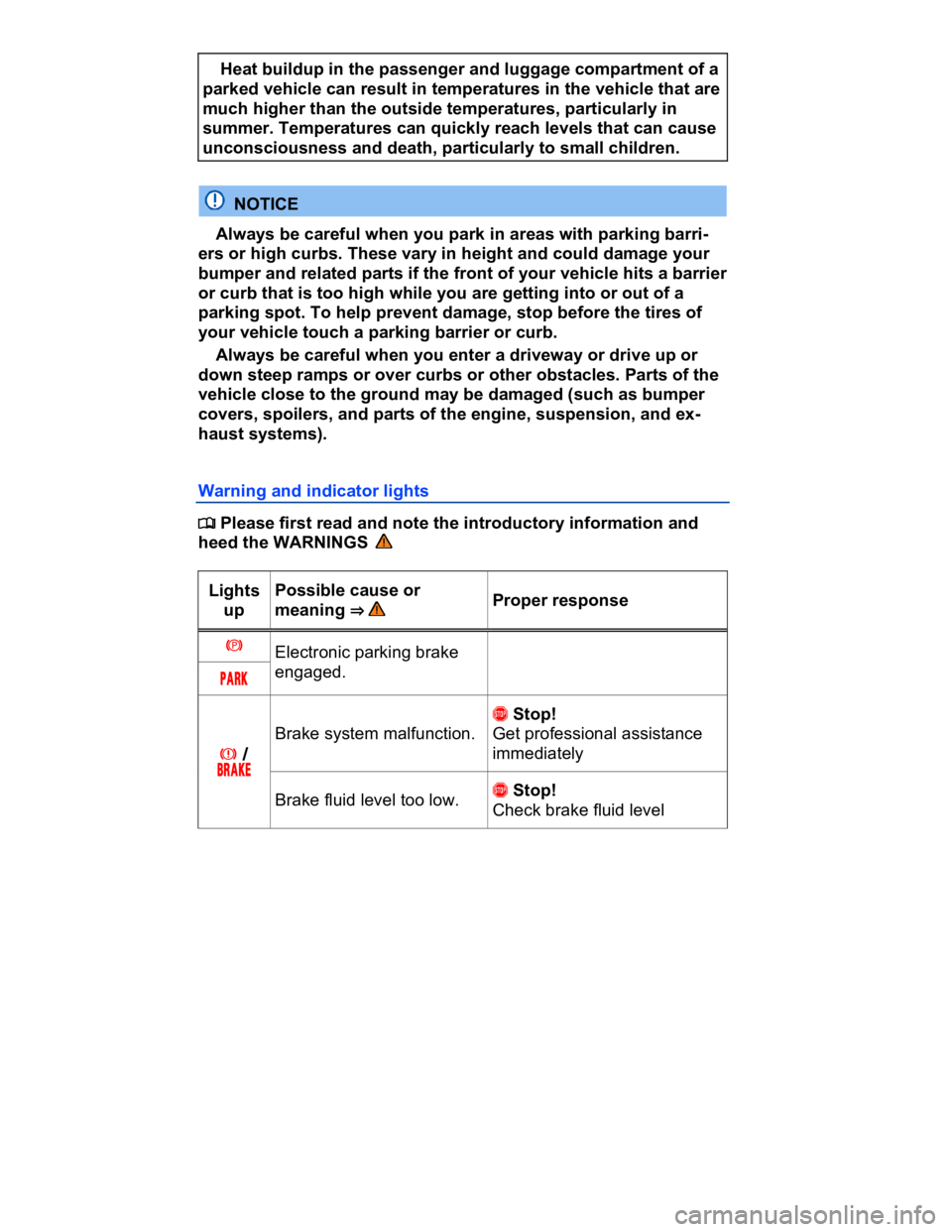
� Heat buildup in the passenger and luggage compartment of a
parked vehicle can result in temperatures in the vehicle that are
much higher than the outside temperatures, particularly in
summer. Temperatures can quickly reach levels that can cause
unconsciousness and death, particularly to small children.
NOTICE
� Always be careful when you park in areas with parking barri-
ers or high curbs. These vary in height and could damage your
bumper and related parts if the front of your vehicle hits a barrier
or curb that is too high while you are getting into or out of a
parking spot. To help prevent damage, stop before the tires of
your vehicle touch a parking barrier or curb.
� Always be careful when you enter a driveway or drive up or
down steep ramps or over curbs or other obstacles. Parts of the
vehicle close to the ground may be damaged (such as bumper
covers, spoilers, and parts of the engine, suspension, and ex-
haust systems).
Warning and indicator lights
�
Page 342 of 578
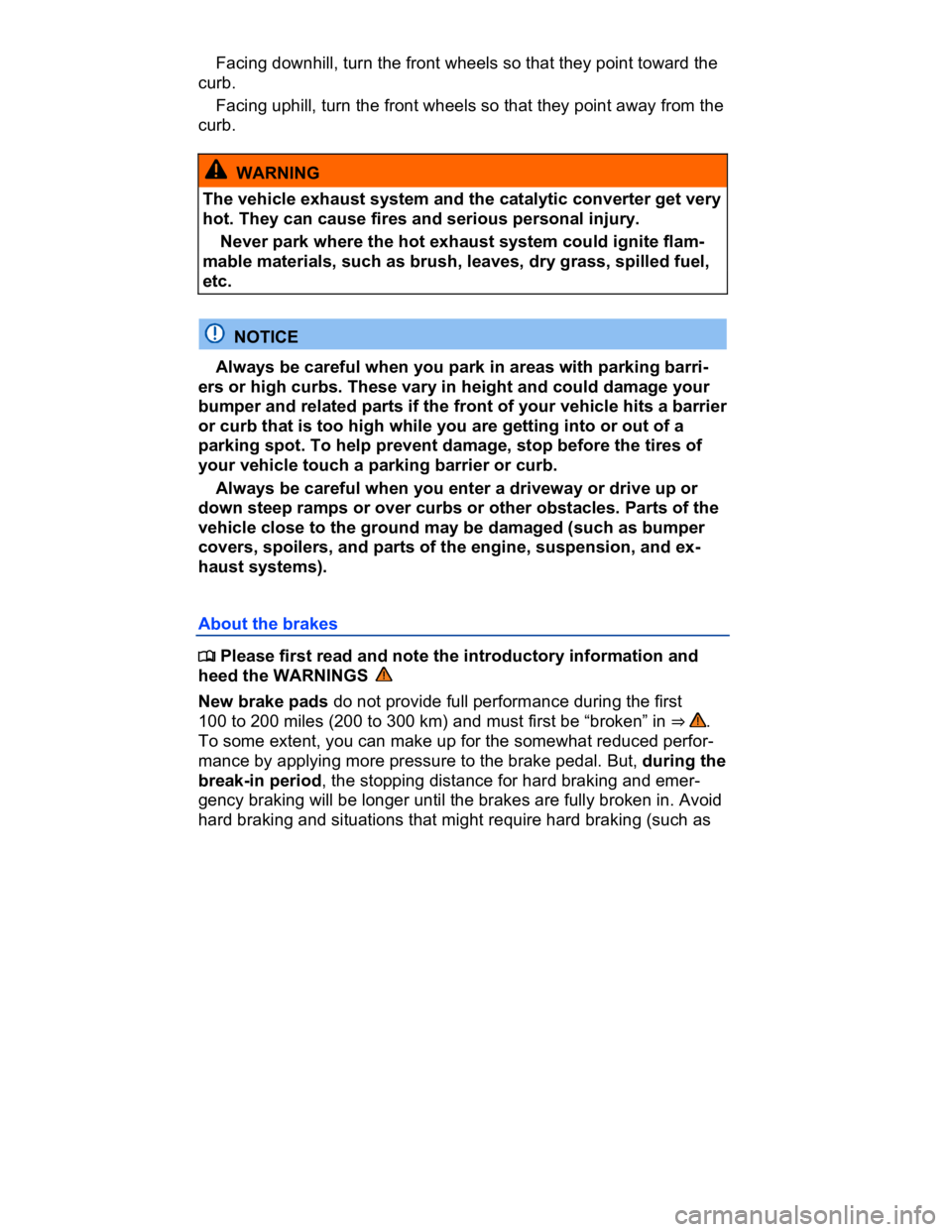
� Facing downhill, turn the front wheels so that they point toward the
curb.
� Facing uphill, turn the front wheels so that they point away from the
curb.
WARNING
The vehicle exhaust system and the catalytic converter get very
hot. They can cause fires and serious personal injury.
� Never park where the hot exhaust system could ignite flam-
mable materials, such as brush, leaves, dry grass, spilled fuel,
etc.
NOTICE
� Always be careful when you park in areas with parking barri-
ers or high curbs. These vary in height and could damage your
bumper and related parts if the front of your vehicle hits a barrier
or curb that is too high while you are getting into or out of a
parking spot. To help prevent damage, stop before the tires of
your vehicle touch a parking barrier or curb.
� Always be careful when you enter a driveway or drive up or
down steep ramps or over curbs or other obstacles. Parts of the
vehicle close to the ground may be damaged (such as bumper
covers, spoilers, and parts of the engine, suspension, and ex-
haust systems).
About the brakes
�
Page 350 of 578
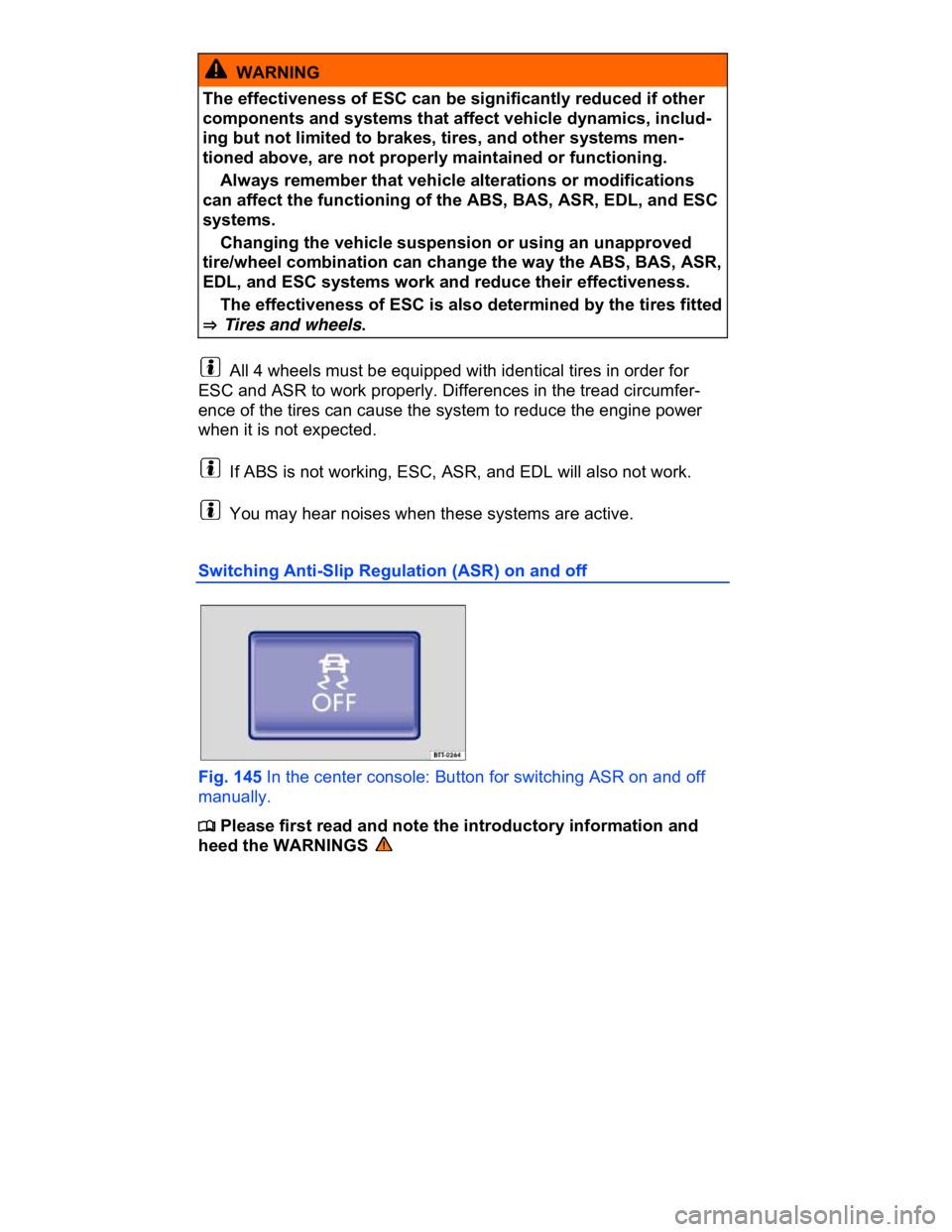
WARNING
The effectiveness of ESC can be significantly reduced if other
components and systems that affect vehicle dynamics, includ-
ing but not limited to brakes, tires, and other systems men-
tioned above, are not properly maintained or functioning.
� Always remember that vehicle alterations or modifications
can affect the functioning of the ABS, BAS, ASR, EDL, and ESC
systems.
� Changing the vehicle suspension or using an unapproved
tire/wheel combination can change the way the ABS, BAS, ASR,
EDL, and ESC systems work and reduce their effectiveness.
� The effectiveness of ESC is also determined by the tires fitted
⇒ Tires and wheels.
All 4 wheels must be equipped with identical tires in order for
ESC and ASR to work properly. Differences in the tread circumfer-
ence of the tires can cause the system to reduce the engine power
when it is not expected.
If ABS is not working, ESC, ASR, and EDL will also not work.
You may hear noises when these systems are active.
Switching Anti-Slip Regulation (ASR) on and off
Fig. 145 In the center console: Button for switching ASR on and off
manually.
�
Page 483 of 578
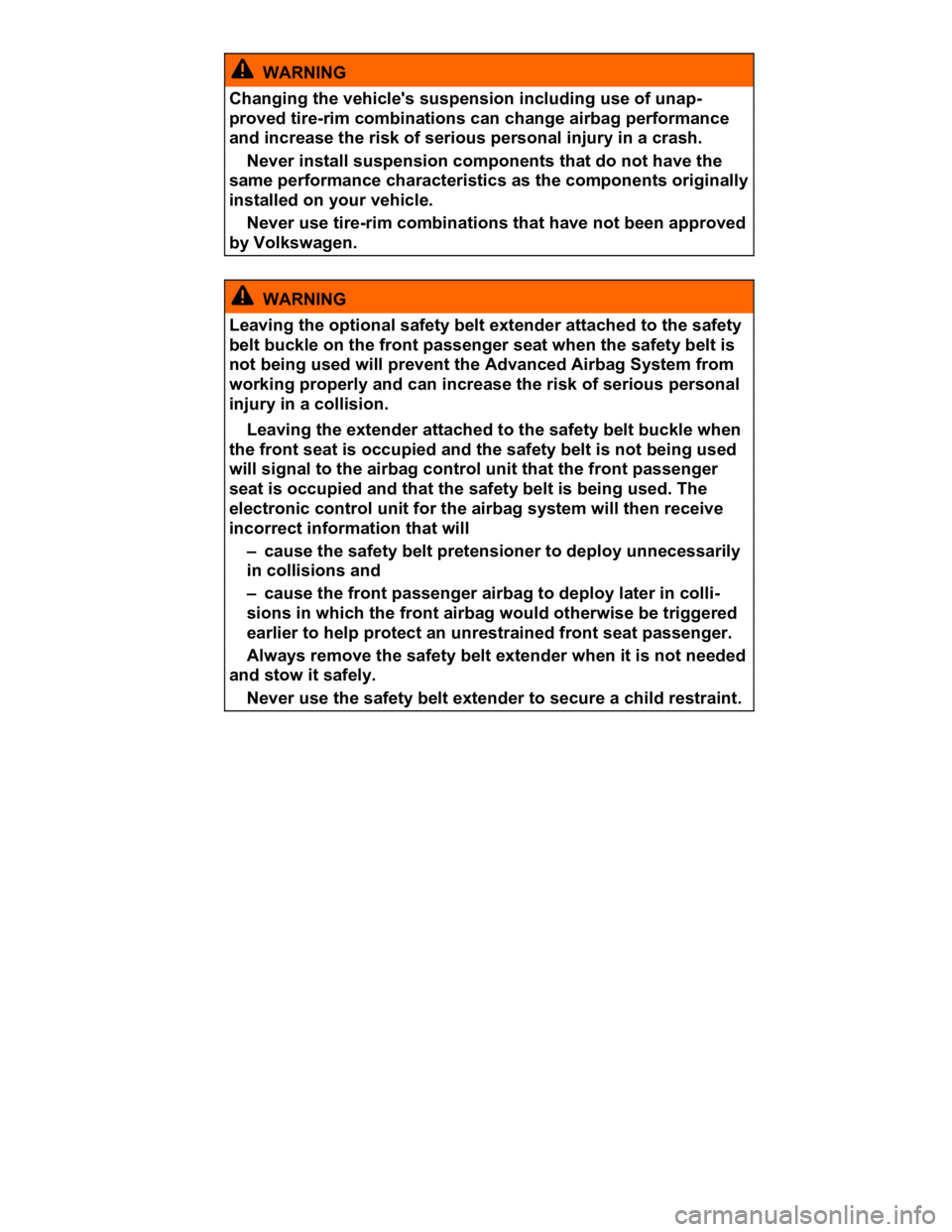
WARNING
Changing the vehicle's suspension including use of unap-
proved tire-rim combinations can change airbag performance
and increase the risk of serious personal injury in a crash.
� Never install suspension components that do not have the
same performance characteristics as the components originally
installed on your vehicle.
� Never use tire-rim combinations that have not been approved
by Volkswagen.
WARNING
Leaving the optional safety belt extender attached to the safety
belt buckle on the front passenger seat when the safety belt is
not being used will prevent the Advanced Airbag System from
working properly and can increase the risk of serious personal
injury in a collision.
� Leaving the extender attached to the safety belt buckle when
the front seat is occupied and the safety belt is not being used
will signal to the airbag control unit that the front passenger
seat is occupied and that the safety belt is being used. The
electronic control unit for the airbag system will then receive
incorrect information that will
– cause the safety belt pretensioner to deploy unnecessarily
in collisions and
– cause the front passenger airbag to deploy later in colli-
sions in which the front airbag would otherwise be triggered
earlier to help protect an unrestrained front seat passenger.
� Always remove the safety belt extender when it is not needed
and stow it safely.
� Never use the safety belt extender to secure a child restraint.
Page 502 of 578
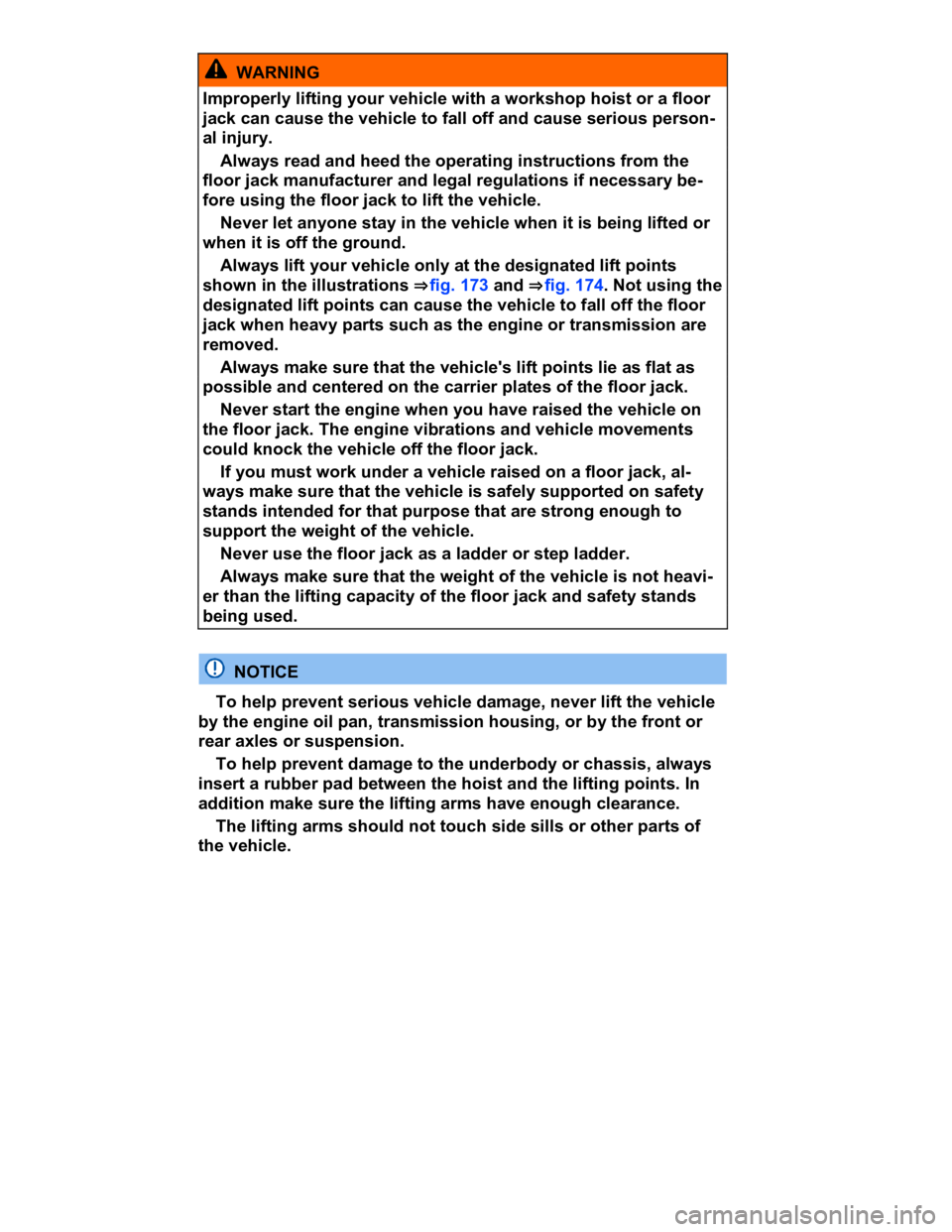
WARNING
Improperly lifting your vehicle with a workshop hoist or a floor
jack can cause the vehicle to fall off and cause serious person-
al injury.
� Always read and heed the operating instructions from the
floor jack manufacturer and legal regulations if necessary be-
fore using the floor jack to lift the vehicle.
� Never let anyone stay in the vehicle when it is being lifted or
when it is off the ground.
� Always lift your vehicle only at the designated lift points
shown in the illustrations ⇒ fig. 173 and ⇒ fig. 174. Not using the
designated lift points can cause the vehicle to fall off the floor
jack when heavy parts such as the engine or transmission are
removed.
� Always make sure that the vehicle's lift points lie as flat as
possible and centered on the carrier plates of the floor jack.
� Never start the engine when you have raised the vehicle on
the floor jack. The engine vibrations and vehicle movements
could knock the vehicle off the floor jack.
� If you must work under a vehicle raised on a floor jack, al-
ways make sure that the vehicle is safely supported on safety
stands intended for that purpose that are strong enough to
support the weight of the vehicle.
� Never use the floor jack as a ladder or step ladder.
� Always make sure that the weight of the vehicle is not heavi-
er than the lifting capacity of the floor jack and safety stands
being used.
NOTICE
� To help prevent serious vehicle damage, never lift the vehicle
by the engine oil pan, transmission housing, or by the front or
rear axles or suspension.
� To help prevent damage to the underbody or chassis, always
insert a rubber pad between the hoist and the lifting points. In
addition make sure the lifting arms have enough clearance.
� The lifting arms should not touch side sills or other parts of
the vehicle.